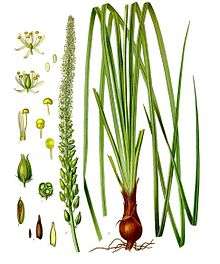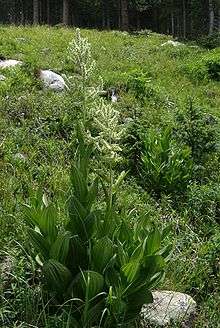Melanthiaceae
Melanthiaceae, also called the bunchflower family,[2][3] is a family of flowering herbaceous perennial plants native to the Northern Hemisphere.[4] Along with many other lilioid monocots, early authors considered members of this family to belong to the family Liliaceae, in part because both their sepals and petals closely resemble each other and are often large and showy like those of lilies,[4] while some more recent taxonomists have placed them in a family Trilliaceae. The most authoritative modern treatment, however, the APG III system of 2009 (unchanged from the 2003 APG II system and the 1998 APG system), places the family in the order Liliales, in the clade monocots. Circumscribed in this way, the family includes up to 17 genera.
| Melanthiaceae | |
|---|---|
 | |
| Schoenocaulon officinale | |
| Scientific classification | |
| Kingdom: | Plantae |
| Clade: | Tracheophytes |
| Clade: | Angiosperms |
| Clade: | Monocots |
| Order: | Liliales |
| Family: | Melanthiaceae Batsch ex Borkh.[1] |
| Genera | |
|
See text | |
Familiar members of the family include the genera Paris and Trillium.

Genera and species
As of August 2013, the World Checklist of Selected Plant Families accepted 17 genera in the family.[5] They have been divided into five tribes. It has a total of ca 173 known species.[6] Generic assignments within the tribe Melanthieae in particular have been changed radically as a result of molecular phylogenetic studies in the 21st century.[4] Some taxonomists have combined the three genera of Heloniadae into one genus (Helonias).[7]
- Heloniadeae
- Helonias L.
- Heloniopsis A.Gray
- Ypsilandra Franch.
- Chionographideae
- Chamaelirium Willd.
- Chionographis Maxim.
- Amianthium A.Gray
- Anticlea Kunth
- Melanthium J.Clayton ex L.
- Schoenocaulon A.Gray
- Stenanthium (A.Gray) Kunth
- Toxicoscordion Rydb.
- Veratrum L.
- Zigadenus Michx.
- Xerophylleae
- Xerophyllum Michx.
- Parideae
- Paris L. (including Daiswa and Kinugasa)
- Pseudotrillium S.B.Farmer
- Trillium L. (including Trillidium)
References
- Angiosperm Phylogeny Group (2009). "An update of the Angiosperm Phylogeny Group classification for the orders and families of flowering plants: APG III". Botanical Journal of the Linnean Society. 161 (2): 105–121. doi:10.1111/j.1095-8339.2009.00996.x. Archived from the original (PDF) on 2017-05-25. Retrieved 2013-06-26.
- https://gobotany.nativeplanttrust.org/family/melanthiaceae/
- https://www.wildflowers-and-weeds.com/Plant_Families/Melanthiaceae.htm
- Zomlefer, WB; NH Williams; WM Whitten; WS Judd (2001). "Generic circumscriptions and relationships in the tribe Melanthieae (Liliales, Melanthiaceae), with emphasis on Zigadenus: Evidence from ITS and TRNL-F sequence date". American Journal of Botany. Botanical Society of America. 88 (9): 1657–1669. doi:10.2307/3558411. JSTOR 3558411. PMID 21669700.
- Search for "Melanthiaceae", "World Checklist of Selected Plant Families". Royal Botanic Gardens, Kew. Retrieved 2013-08-27.
- Christenhusz, M. J. M. & Byng, J. W. (2016). "The number of known plants species in the world and its annual increase". Phytotaxa. Magnolia Press. 261 (3): 201–217. doi:10.11646/phytotaxa.261.3.1.
- Tanaka, N. (1998). "Phylogenetic and Taxonomic Studies on Helonias, Ypsilandra and Heloniopsis III. Taxonomic Revision". Journal of Japanese Botany. 73 (2): 102–115. Retrieved 2019-04-04.
External links
- Melanthiaceae [in a very wide sense], Trilliaceae in L. Watson and M.J. Dallwitz (1992 onwards). The families of flowering plants: descriptions, illustrations, identification, information retrieval. Version: 3 May 2006. http://delta-intkey.com.
- links and more links at CSDL, Texas
| Wikimedia Commons has media related to Melanthiaceae. |
| Wikispecies has information related to Melanthiaceae |